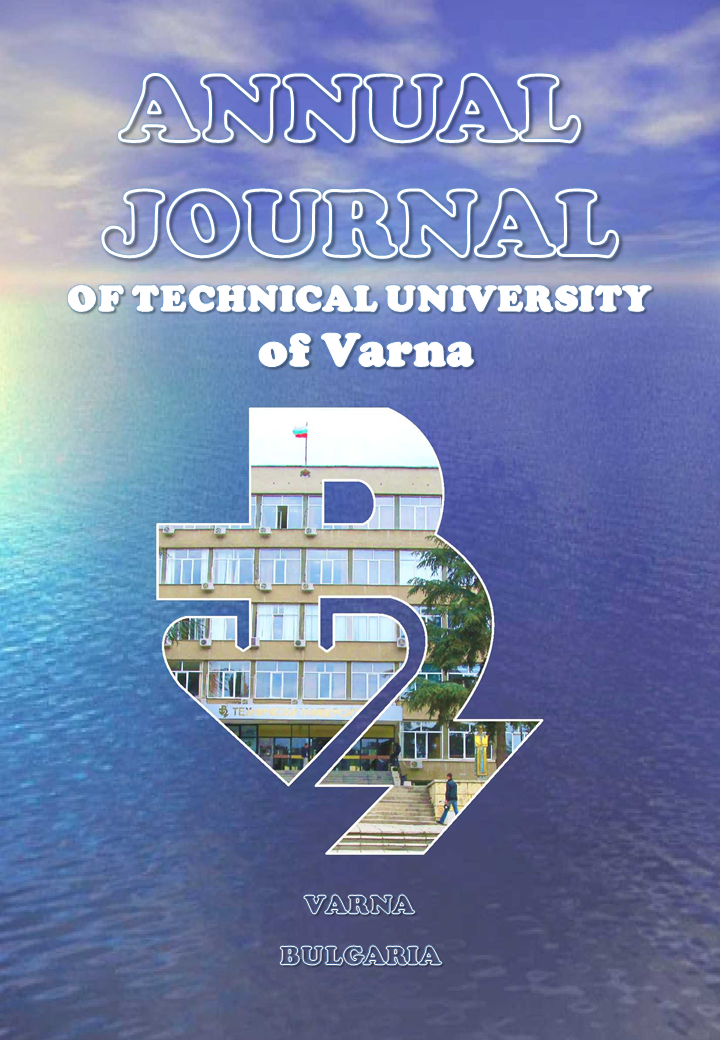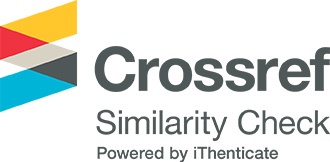Research on the effect of different types of fertilization on the maize (Zea mays L.)
DOI:
https://doi.org/10.29114/ajtuv.vol7.iss1.282Ключевые слова:
maize, foliar fertilization, yield, biometric parameters, proteinАннотация
Maize is the cereal crop with the greatest productive potential and production in the world. A field research experiment was conducted in the field settings of the Department of "Plant Production" at the Technical University of Varna, to evaluate the effect of foliar fertilizers on the productivity and quality of Dekalb maize hybrids. Four fertilizer variants were examined and the following biometric parameters were assessed: grain yield, weight per 1000 grains, length of cob, number of rows in cob, number of grains in cob, number of grains per row, weight of grain in cob and weight of the cob. A biochemical analysis of the maize grain was performed and the content of protein, starch and fat was determined. It was established that the combined pairing of soil and foliar fertilization leads to increased productivity and enhanced biometric parameters under study, with the highest values being obtained in the variant ammonium nitrate (rate of 12 kg/dа) + 250 ml/dа NPK 2.5 SO3 with composition 3.0 N: 1.5 P: 10 K: 2.5 SO3 + 250 ml/da SO3 10% Zn, 3% N (sulfides with zinc and nitrogen). It was also ascertained, through the use of the same combination, that the maize hybrids under examination contain the highest amount of protein. Provided, from the findings of the experiment, is a conclusive evidence, that the combination of sowing soil fertilization with ammonium nitrate (rate of 12 kg/da) and two foliar fertilizers (rate of 250 ml/da) – NPK 2.5 SO3 + SO3, 10% Zn, 3% N improved the productivity and quality of the investigated Dekalb maize hybrids.
Скачивания
Библиографические ссылки
<p>Amanullah, Saleem, A., Iqbal, A. & Fahad, S. (2016). Foliar Phosphorus and Zinc Application Improve Growth and Productivity of Maize (<em>Zea mays</em> L.) Under Moisture Stress conditions in Semi-Arid Climates. <em>Journal of Microbial & Biochemical Technology</em>, 8 (5), pp. 433-439. <br /><a href="https://doi.org/10.4172/1948-5948.1000321" target="_blank">Crossref</a></p>
<p>Aslam, M., Zamir, M. S. I., Afzal, I., Yaseen, M., Mubeen, M. & Shoaib, A. (2013). Drought stress, its effect on maize production and development of drought tolerance through potassium application. <em>Cercetări Agronomice în Moldova</em>, 46 (2), pp. 99-114. Retrieved from <a href="https://www.researchgate.net/publication/305471407" target="_blank">https://www.researchgate.net/publication/305471407</a></p>
<p>Brankov, M., Simic, M., Zeljko, D., Rajkovic, M., Mandic, V., & Dragicevic, V. (2020). The Response of Maize Lines to Foliar Fertilizing. <em>Agriculture</em>, 10 (9), pp. 365. <a href="https://doi.org/10.3390/agriculture10090365" target="_blank">https://doi.org/10.3390/agriculture10090365</a></p>
<p>Gerasimova, N. (2013). Effect of postemergence herbicides on yields in maize (<em>Zea mays</em> L.). <em>Scientific works of the University of Ruse</em>, Volume 52, Series 1.1, pp. 52-56 (Bg). Retrieved from <a href="https://www.researchgate.net/publication/356101791" target="_blank">https://www.researchgate.net/publication/356101791</a></p>
<p>Ivanov, M. & Dimitrov, I. (2018). Influence of some agro-technical factors on the productivity of triple crop rotation in the agro-ecological conditions of the Upper Thracian lowland. <em>Bulgarian Journal of Crop Science</em>, 55 (4), pp. 14-23 (Bg). Retrieved from <a href="https://cropscience-bg.org/page/bg-topmenu/about.php" target="_blank">https://cropscience-bg.org/page/bg-topmenu/about.php</a></p>
<p>Ivanov, M. & Dimitrov, I. (2018). Influence of some agro-technical factors on the productivity of triple crop rotation in the agro-ecological conditions of the Upper Thracian lowland. <em>Bulgarian Journal of Crop Science</em>, 55 (4), pp. 14-23 (Bg). Retrieved from <a href="https://cropscience-bg.org/page/bg-topmenu/about.php" target="_blank">https://cropscience-bg.org/page/bg-topmenu/about.php</a></p>
<p>Jakab, P., David, Z., & Komarek, F. (2017). Investigation of Foliar Fertilization in Maize Production. <em>Advanced Research in Life Sciences</em>, 1 (1), pp. 1-6. <br /><a href="https://doi.org/10.1515/arls-2017-0001" target="_blank">Crossref</a></p>
<p>Karov, St., (ed.). (2004). Basics of organic farming. <em>Bioselena Foundation</em>, pp. 50 (Bg). Retrieved from <a href="https://orgprints.org/id/eprint/30831/1/Organic_Farming_Bulgaria.pdf" target="_blank">https://orgprints.org/id/eprint/30831/1/Organic_Farming_Bulgaria.pdf</a></p>
<p>Koteva, V. & Bazitov, R. (2013). Mineral Fertilization Effect’s on Common Wheat, Cultivated in Favorable and Risky Climate Conditions. <em>Bulgarian Journal of Soil Science, Agrochemistry and Ecology</em>, Vol. XLVII, № 3, pp. 39-46 (Bg). Retrieved from <a href="https://soilscience-bg.org/page/en-topmenu/home.php" target="_blank">https://soilscience-bg.org/page/en-topmenu/home.php</a></p>
<p>Koteva, V. & Маrcheva, М. (2016). Productivity and Grain Quality of Maize, Cultivated on Pellic Vertisol without Fertilization in South-East Bulgaria. <em>New Knowledge Journal of Science, Anniversary International Scientific and Applied Conference – UARD</em>, <em>Bulgaria</em>, pp. 181-187 (Bg). Retrieved from <a href="https://science.uard.bg/index.php/newknowledge/index" target="_blank">https://science.uard.bg/index.php/newknowledge/index</a></p>
<p>Koteva, V., Kostadinova, S. & Popova, Yo. (2014). Effectiveness of Mineral Fertilization on Maize for Grain, Cultivated in Pellic Vertisol, FAO in Southeastern Bulgaria in Favorable and Risky Meteorological Conditions. <em>Bulgarian Journal of Soil Science, Agrochemistry and Ecology</em>, Vol. XLVIII, № 2, pp. 34-42 (Bg). Retrieved from <a href="https://soilscience-bg.org/page/en-topmenu/home.php" target="_blank">https://soilscience-bg.org/page/en-topmenu/home.php</a></p>
<p>Kuneva V. & Bazitov, R. (2014). Influence of fertilization on the level on the structural indexes of maize hybrid LG 35.62. <em>Scientific works of the University of Ruse</em>, Volume 53, Series 1.1, pp. 44-47 (Bg). Retrieved from <a href="https://conf.uni-ruse.bg/bg/docs/cp14/1.1/1.1-8.pdf" target="_blank">https://conf.uni-ruse.bg/bg/docs/cp14/1.1/1.1-8.pdf</a></p>
<p>Kuneva V., Kalaidzieva, R., Маtev, А., & Кirchev, H. (2015). Evaluation of the Factors Fertilization and Irrigation Regimes on the Yield of Maize Based of Mathematical-Statistical Analysis. <em>Bulgarian Journal of Crop Science</em>, 5, pp. 79-83 (Bg). Retrieved from <a href="https://www.researchgate.net/publication/286924867%20" target="_blank">https://www.researchgate.net/publication/286924867 </a></p>
<p>Mikova, A., Alexandrova, P., & Dimitrov, I. (2013). Maize grain yield response to N fertilization, climate and hybrids. <em>Bulgarian Journal of Agricultural science</em>, 19 (3), pp. 454-460. Retrieved from <a href="https://www.agrojournal.org/19/03-10.pdf" target="_blank">https://www.agrojournal.org/19/03-10.pdf</a></p>
<p>Mitova, I. & Dinev, N. (2017). Agricultural development - Conventional and/or organic? Sustainable. <em>East-West Publishing House - Sofia</em>, pp.167 (Bg). Retrieved from <a href="https://www.researchgate.net/publication/370389070_" target="_blank">https://www.researchgate.net/publication/370389070</a></p>
<p>Nikolova, М. (2018). Plant nutrition management - modern approaches. <em>Plant protection</em> (Bg), Retrieved from <a href="https://www.plant-protection.com/article/902" target="_blank">https://www.plant-protection.com/article/902</a></p>
<p>Nyagorme, D., Amoah A. & Gyapong, T. (2021). Response of maize (<em>Zea mays</em> L.) to foliar and soil applied fertilizers in the Semi-deciduous forest zone of Ghana. <em>African Journal of Agricultural Research</em>, 17 (8), pp. 1114-1122.<br /><a href="https://doi.org/10.5897/ajar2021.15561" target="_blank">Crossref</a></p>
<p>Petkova, V., Yusmen, М. & Koleva-Valkova, L. (2014). Effect of Foliar Fertilizers on Young Sunflower and Maize Plants under Nitrogen Deficiency. <em>Agricultural University – Plovdiv, Scientific Works</em>, vol. LVIII, pp. 241-248 (Bg). Retrieved from <a href="http://nauchnitrudove.au-plovdiv.bg/28-" target="_blank">http://nauchnitrudove.au-plovdiv.bg/28</a></p>
<p>Todorova, S., Trendafilov, K. & Valcheva, V. (2013). Differentiation of fertilization rates with phosphorus and potassium based on geospatial data for their reserves in soil. <em>Scientific papers series a. agronomy</em>, vol. LVI, pp. 126-132. Retrieved from <a href="https://www.yumpu.com/en/document/view/28043732/scientific-papers-series-a-agronomy" target="_blank">https://www.yumpu.com/en/document/view/28043732/scientific-papers-series-a-agronomy</a></p>
<p>Todorova, S., Simeonova, N., Trendafilov, K. & Valcheva, V. (2012). Change of available forms of nitrogen and phosphorus in alluvial-meadow soil, after long-term fertilization. <em>Agricultural Science and Technology</em>, vol. 4, pp. 388-391. Retrieved from <a href="https://agriscitech.eu/" target="_blank">https://agriscitech.eu/</a></p>
<p>Toncheva, R. (2016). Investigation the Productivity of Maize in Different Agroecological Conditions, Fertilization and Plant Density I. Non-Irrigated Conditions. <em>Bulgarian Journal of Soil Science, Agrochemistry and Ecology</em>, 50, 2, pp. 50-59 (Bg). Retrieved from <a href="https://soilscience-bg.org/page/en-topmenu/home.php" target="_blank">https://soilscience-bg.org/page/en-topmenu/home.php</a></p>
<p>Toungos, M.D., Bamai, N. & Yamma, K.M. (2016). Effects of Combined Application of NPK and Foliar Fertilizer (Boost-Extra) On Yield and Yield Components of Maize (Zea mays L.) In Mubi, Northern Guinea Savannah Zone of Nigeria. <em>International Journal of Innovative Agriculture & Biology Research,</em> 4 (3), pp. 17-25. Retrieved from <a href="http://www.seahipaj.org/" target="_blank">http://www.seahipaj.org/</a></p>
<p>Traykov, N., Toncheva, R. & Dimitrov, I. (2017). Investigation of the productivity of maize depending on agro-ecological conditions and applied agrotechnics. <em>Bulgarian Journal of Soil Science, Agrochemistry and Ecology</em>, 51, 1, pp. 12-24 (Bg). Retrieved from <a href="https://soilscience-bg.org/page/en-topmenu/home.php" target="_blank">https://soilscience-bg.org/page/en-topmenu/home.php</a></p>
Загрузки
Опубликован
Как цитировать
Выпуск
Раздел
Лицензия
СОГЛАШЕНИЕ О ПУБЛИКАЦИИ
Ежегодный журнал Технического университета Варны (ЕЖТУВ) гарантирует опубликование оригинальных материалов и, в то же время, предоставление своим авторам значительной свободы. Для этого мы придерживаемся гибкой политики в отношении авторских прав, означающей, что передача издателю авторских прав отсутствует, и авторы сохраняют эксклюзивные авторские права на свою работу.
При подаче рукописи ответственный автор должен принять условия, изложенные в данном Соглашении о публикации и состоящие в следующем:
ПРЕДОСТАВЛЕНИЕ ПРАВ ОТВЕТСТВЕННЫМ АВТОРОМ
Ответственный автор предоставляет AJTUV в течение полного срока действия авторского права и любых продлений или подновлений этого срока следующее:
• безотзывное неисключительное право публиковать, воспроизводить, переиздавать, передавать, распространять и иным образом использовать Работу в электронных и печатных изданиях и в производных произведениях по всему миру, на всех языках и во всех известных в настоящее время или появившихся впоследствии СМИ.
• безотзывное неисключительное право создавать и хранить электронные архивные копии Работы, в том числе право депонирования Работы в цифровых хранилищах открытого доступа.
• безотзывное неисключительное право лицензировать других лиц на воспроизведение, перевод, переиздание, передачу и распространение Работы при условии, что Авторы должным образом указаны (в настоящее время это осуществляется путем публикации Работы в соответствии с лицензией Creative Commons Attribution 4.0 Unported License).
Авторское право на Работу принадлежит Авторам. Авторы сохраняют за собой права на патенты, товарные знаки и другие права на интеллектуальную собственность.
ОБЯЗАННОСТИ ОТВЕТСТВЕННОГО АВТОРА
При распространении или повторной публикации Работы Ответственный Автор соглашается указывать AJTUV, в котором опубликована Работа, как источник первой публикации. Ответственный Автор гарантирует, что соавторы также будут согласны, чтобы Работа опубликовалась в AJTUV, который будет рассматриваться как первичный источник публикации в случае ее распространения или переиздания.
ГАРАНТИИ СО СТОРОНЫ ОТВЕТСТВЕННОГО АВТОРА
Ответственный автор гарантирует, что его Работа не нарушает закон или права какой-либо третьей стороны и, в частности, что Работа не содержит дискредитирующие материалы и не нарушает какие-либо литературные или имущественные права, права интеллектуальной собственности или любые другие права, касающиеся неприкосновенности частной жизни. Ответственный автор гарантирует, что Работа является оригинальной, официально не публиковалась ни в одном другом рецензируемом журнале, книге или редактируемом сборнике, и не рассматривается для какой-либо подобной публикации. Ответственный автор также гарантирует, что он или она имеет полное право заключить это соглашение. Если Работа была подготовлена совместно с другими соавторами, Ответственный Автор гарантирует, что все соавторы согласны с представлением и публикацией Работы.
Ответственный автор обязуется не вовлекать ЕЖТУВ в какие-любо нарушения вышеупомянутых заявлений и гарантий.
ПРАВА И ОБЯЗАННОСТИ ЕЖТУВ
ЕЖТУВ соглашается опубликовать Работу от имени ее авторов. ЕЖТУВ получает от имени авторов полномочия по обеспечению предусмотренных данным соглашением прав в отношении третьих сторон (например, в случаях плагиата или нарушения авторских прав).
Заявление о конфиденциальности ЕЖТУВ
Имена и адреса электронной почты, существующие на веб-сайте ЕЖТУВ, будут использоваться только и исключительно в заявленных целях данного ежегодного журнала и не будут доступны в иных целях или для любой другой стороны.
Вся предоставленная личная информация останется исключительно у издателя и не будет передаваться каким-либо внешним лицам, если на это не будет предоставлено предварительное разрешение.
Ваша личная информация никоим образом не будет продаваться, распространяться или публиковаться.









